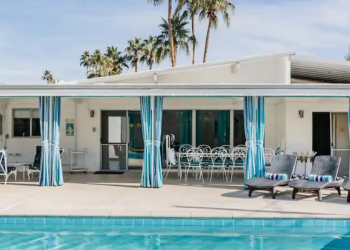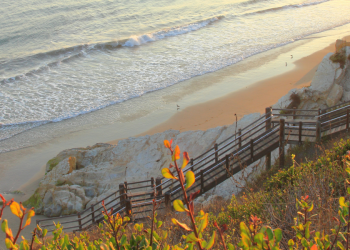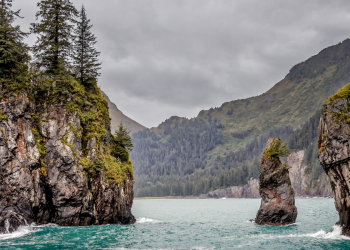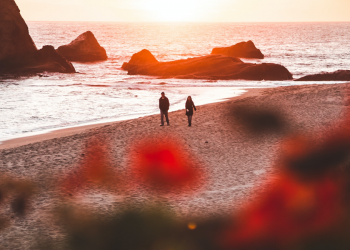From Acadia to Zion, America’s backyard is made up of 63 richly diverse, historic, and stunningly scenic national parks, the lion’s share of which are found in the West. California alone is home to nine including one of the system’s most recognizable crown jewels, Yosemite. Between them, there’s much to explore—active volcanos, deserts with dark skies perfect for stargazing, pine-scented forests, wildflower meadows, caves dripping in stalactites, lush rainforests, islands crawling with critters found nowhere else in the world, the US’s deepest lake, and the largest trees on Earth. Whether your idea of a good time is splurging on a bucket-list stay in a grand lodge, going off-grid for a digital detox, photographing wildlife, or stringing several parks together to create a road trip to remember, our guide to the best West Coast national parks can help find sylvan spots to suit your vacation style.
Yosemite National Park, California

Where to Stay:
Overnighting at the grand dame of national park hotels, The Ahwahnee, a 1927 Arts and Crafts luxury lodge, is a must as is ice skating in Curry Village, a High Sierra tradition for almost a century.
Crater Lake National Park, Oregon

Created 7,700 years ago when a forcible blast triggered an ancient Oregon volcano to collapse into itself, Crater Lake is the deepest lake in the nation (and one of the world’s purest). It’s also the namesake and breathtaking centerpiece of the fifth-oldest national park, which is a four-hour drive southeast of Portland. Stay topside, using the 33-mile Rim Drive, its 30 overlooks, and five picnic areas, for a bird’s-eye view of the big blue beauty from a plethora of angles. Those who are a little more adventurous and physically fit—it requires a one-mile hike on a dusty incline both ways—can get a closer look at the caldera and Wizard Island aboard a boat tour. (Only available in the summer.)
Where to Stay:
Built 1915, Crater Lake Lodge, which shuts seasonally from mid-October through April when the region typically gets a lot of snow, is chock full of old-timey touches including stone facades, paned windows, a crackling lobby fire, and no TVs.
Joshua Tree National Park, California

The two-desert destination just outside of Palm Springs is a longtime social media staple for boho hipsters, hikers, hippies, and hat- and nap dress-wearing influencers that became even more popular during the pandemic. Luckily, in a park bigger than the state of Rhode Island, it’s fairly easy to spread out and avoid crowds. Come for the Joshua Tree NP’s signature Dr. Seussian trees, craggy canyons, palm oases, and towering boulder piles. Stay for night-sky parties, the gold and silver rush history (Lost Horse Mine is considered to be one of the best-preserved mills), and the chance to see tarantulas and roadrunners racing to cross the street.
Insider Tip:
Whatever you do, don’t forget to constantly apply sunscreen and stay hydrated because the summer temperatures are no joke. Allot time to wander around nearby towns and the area’s kookiest attractions like a geodesic dome where sound baths are performed, a one-hour Fotomat turned Crochet Museum, or Noah Purifoy’s found art sculpture garden.
Olympic National Park, Washington

Just west of Seattle on the Olympic Peninsula between Puget Sound and the Pacific Ocean, Olympic National Park’s nearly one million acres and three distinct ecosystems provide visitors with a lot of bang for their buck—or 30 bucks to be more precise. In the span of a day, it’s possible to go from tide-pooling at sea level at Mora’s Hole in the Wall to running rapids through an old-growth rainforest on the Elwha River (the best season is spring and early summer) to ascending 5,242 feet to Hurricane Ridge where hiking or snowshoeing steep trails is rewarded with panoramic views of glacier-capped mountains.
Where to Stay:
Lodging ranges from spartan campgrounds to warmly appointed century-old resorts. Start your day at Kalaloch Lodge with a misty morning stroll along a driftwood-dotted beach or end it on the cozy porch watching the sun drop across the water at Lake Crescent Lodge’s westerly view over clear glacial waters makes for exceptional sunset unions.
Lassen Volcanic National Park, California

Nestled in the southernmost reach of the Cascade Mountains at an elevation range at 5,500 to 10,457 feet, Northern California’s Lassen Volcanic National Park is 166 geologically active square miles of wild country where black bears and mountain lions still roam, campers trade tall fish tales while admiring countless constellations in inky night skies, hikers wind through 150 miles of trails including a 17-mile section of the Pacific Crest Trail, birders check species like the nation’s largest woodpecker and hummingbird with an iridescent pink head off their life lists, kids cannonball into freezing lakes and creeks (there are over 200 here) and winter visitors scamper across fields of white on free ranger-led snowshoe treks. With its hydrothermal zones full of bubbly mud pots, sulfur vents, acidic ponds, and steamy fumaroles like Sulphur Works and Bumpass Hell Trail, it’s a good West Coast National Park substitute if a Yellowstone trip isn’t in the cards.
Insider Tip:
Learn more about Lassen Peak’s devastating 1914-1915 eruptions and see a working seismograph at the Loomis Museum. Be aware that much of the park and its facilities are closed in winter.
Mount Rainier National Park, Washington

The 14,410-foot majestic Mount Rainier stands sentinel over the central-west Washington landscape, beckoning to relentless roamers jonesing for their next fix of fresh air and fitness with the promise of winter sledding and snowboarding, scenic drives, springtime saunters around wildflower meadows and forested slopes, autumnal color explosions, fishing, mountaineering, arresting vistas from ridge roads, serene kayaking on a glassy lake, and potential sightings of rare woodland creatures like moles, pine martens, jumping mice, bobcats and, as of 2020, the first wolverines witnessed within park borders in more than 100 years. The park is within 200 miles of Seattle, Tacoma, and Portland.
Insider Tip:
If you have extra time and the desire to check another national monument off the bucket list, it’s only a two-hour drive to Mount St. Helens. Head to the west side to see the crater and the reborn blast zone left by the devastating 1980 eruption.
Channel Islands National Park, California

If you’ve ever wondered what coastal SoCal was like B.C. (before colonization, cars, or concrete), set sail for the five isles (San Miguel. Santa Rosa, Santa Cruz, Anacapa, and Santa Barbara) and the swath of protected sea that surrounds them that make up the secluded Channel Islands National Park. Getting to them requires advance planning as you can only arrive by boat from Ventura (Island Packers Cruises) or plane (Channel Islands Aviation) and hanging out there is the definition of roughing it as there are no hotels or restaurants, only two islands have potable water, and even less have flush toilets. But the archipelago’s mostly untouched beauty—think rolling hills, nest-covered cliffs, ancient Chumash Indian-painted sea caves, rock arches, bustling kelp forests, a petrified forest, secret coves, and spouting whales—is most certainly worth the bother.
Insider Tip:
Be sure to book a kayaking excursion and be on the lookout for the more than 2,000 species of plants and animals, 145 of which aren’t found anywhere else on the planet like island scrub-jays, live-forever plants, and night lizards, that inhabit it.
Death Valley National Park, California

At 3,422,024 acres, Death Valley NP is the largest park outside Alaska. It’s known as the hottest, driest, and lowest park in the entire NPS and the hottest temperature ever recorded on Earth occurred here. It contains the lowest point in North America (Badwater Basin salt flats) and the globe’s lowest-altitude golf course. But this vast desert two hours from Las Vegas and four from Los Angeles offers far more than extreme stats like sand dunes, abandoned mines, horseback rides, vibrantly colored badlands, juniper forests, seasonal super blooms, Native American petroglyphs, and shooting locations from early Star Wars films. Surrounded by mountains, the remote sparsely developed location and ceaseless rays deliver wow moments at both sunrise and sunset, mesmerizing shadows that dance across the valley floor and ideal conditions for stargazing (Why yes, that is the Milky Way!).
Where to Stay:
Post up in the lap of retro luxury at the recently refurbished hillside inn, a hideaway for old Hollywood elite since 1927 and part of the Oasis at Death Valley complex, where you can cool off in the spring-fed perpetually 87-degree pool or with a date shake using fruit from the property’s grove.
North Cascades National Park, Washington

If the mountains are calling, you must go to North Cascades National Park. The alpine playground less than three hours from Seattle by car awaits with enough fresh air, blue skies, 400 miles of rugged trails, bear sightings, crystalline lakes (Diablo Lake is a must-Gram!) and streams, year-round snowy sections, no-frills campgrounds, and jagged remote alps topped by glaciers to satisfy most sorts of great outdoors fantasies. The western side of the park is a temperate rainforest while the eastern side offers a drier ponderosa pine setting.
Insider Tip:
Summer to early fall is the optimal time to visit as rain is less likely and the park has thawed out. (Unless, like Frozen’s Elsa, the cold doesn’t bother you anyway.)
Oregon Caves, Oregon

Although its technical designation is a national monument and preserve, the underground labyrinth deep in the Siskiyou Mountains of the Beaver State is so cool (literally and figuratively) it should be part of any West Coast national park-hopping adventure. Acidic water has seeped into the marble rock below for ages producing spectacular flowstones, stalagmites, stalactites, and a cavernous room 220 beneath the surface. A variety of tour types including a spooky one guided only by lantern light or a strenuous caving escapade that requires boulder scrambles and belly crawls through tight tunnels take wannabe spelunkers through the geologic oddity.
Meet the Author
Carrie Bell is an LA-based writer whose work has appeared in People, Fodor’s, Architectural Digest, Bridal Guide, TripSavvy, and Rolling Stone. The California native has visited 42 countries and 40 states. When she isn’t traveling, the snowglobe collector can usually be found riding a bike, binging Succession, playing board games, and consuming massive amounts of dairy products. Seriously, it’s a problem. Check out her website and Instagram for more of her adventures in wanderlust.







